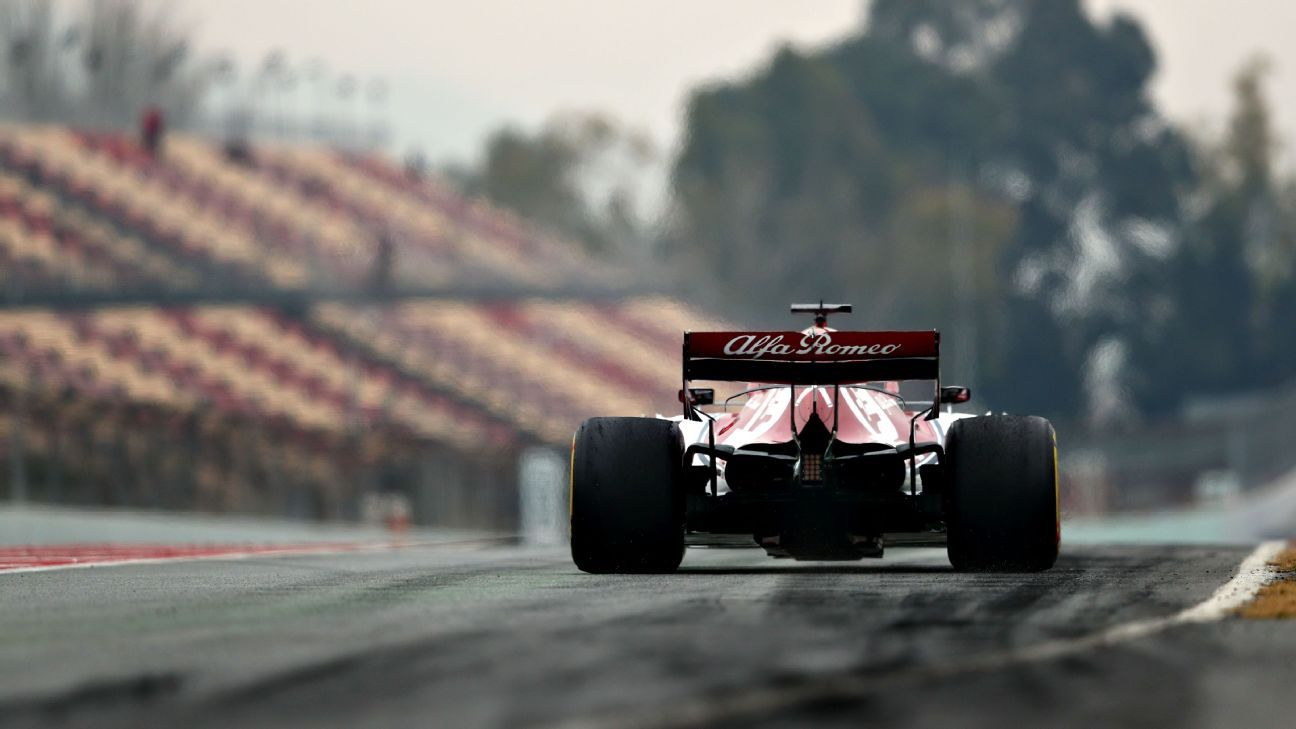A look at how testing suggests the pecking order was at the Circuit de Catalunya over the past two weeks. It could all change at Melbourne’s Albert Park circuit, but this is our estimation of how they stack up ahead of the Australian Grand Prix.
1. Ferrari
Fastest lap: 1:16.221 (Day 8, C5 tyre)
Total laps: 997 (2nd out of 10)
ESPN ranking after week one: 1st
By every pre-season metric available to the media, Ferrari had the fastest car in testing. On ultimate pace it was 0.003s quicker than Mercedes, on tyre-corrected pace it was 0.5s quicker and on race pace it was 0.28s quicker. Sure, Ferrari has set the fastest pre-season lap time for the past four years (and none of those cars have ended the year as championship winners), but it is rare that it has held such a comfortable margin over Mercedes in race pace. The advantage over last year’s title winners may not be the 0.5s Lewis Hamilton talked about last week, but all the indications from testing suggest it is likely to be measured in multiple tenths of a second.
Does that mean we should hand victory at the Australian Grand Prix to Ferrari already? Not quite.
As we saw throughout 2018, holding an advantage at one circuit does not mean it will transfer to another. The Circuit de Catalunya is a purpose-built race track made up of a mix of corners that put the emphasis on high-speed changes of direction. Albert Park, on the other hand, is a temporary circuit made up of of medium-speed corners and just one high-speed change of direction. A car that is quick at one will not necessarily be quick at the other.
The other doubt hanging over Ferrari is reliability. The team had four unplanned stoppages in the final four days in Spain, meaning its lap count over the two weeks of testing came up 193 short of Mercedes. A cooling issue lost the team the best part of Tuesday morning, a wheel rim failure resulted in a serious accident on Wednesday and an exhaust problem and an electrical fault cut the final two days short. The wheel rim failure was the most dramatic of the four, but Ferrari believes it was caused by a foreign object damaging the rim rather than an out-of-the-blue failure. The exhaust issue was brushed off as relatively minor and electrical faults are not uncommon in testing. Even so, the team’s focus over the next week will be on understanding all three and making sure none can reappear in two weeks’ time in Melbourne.
2. Mercedes
Fastest lap: 1:16.224 (Day 8, C5 tyre)
Total laps: 1,190 (1st out of 10)
ESPN ranking after week one: 3rd
Mercedes started the second week of testing by introducing a major upgrade to the W10. The front wing, barge boards, sidepods and rear wing all featured significant changes and, after an underwhelming first week, the world champions started to show some genuine pace. The first thing to note is that the upgrade package was not a reaction to the lack of progress in the first week of testing. This was a large upgrade that was planned long in advance and was always intended to form the basis of the package Mercedes would use at the season opener in Melbourne.
But life for the heavily-revised W10 got off to a tricky start. A loss of oil pressure on Tuesday afternoon resulted in an unscheduled engine change that cost the team the best part of the day. What’s more, the drivers were still reporting instability at the rear at high speeds — an unwanted handling trait that the team had hoped to eliminate with the addition of more downforce. A race sim on Wednesday also went awry when Hamilton experienced excessive graining on the front left tyre as track conditions cooled in the afternoon. That resulted in a four-stop strategy and a series of lap times that lagged behind Max Verstappen’s race sim in the Red Bull on the same day.
By Thursday, however, things started to come together. Valtteri Bottas completed a more representative race sim, making the most of warmer temperatures earlier in the afternoon to complete a two-stop strategy. His 66-lap run happily coincided with Charles Leclerc’s race sim in the Ferrari, offering a rare chance to compare the two cars lap for lap. Ferrari came out on top by an average of 0.28s per lap — or roughly 18 seconds over a race distance — underlining the size of the challenge still facing Mercedes, but putting to rest scare stories of a significantly bigger deficit.
By the end of the two weeks the world champions had also completed more laps than any other team over the eight days, with a total of 1,190. The key now will be to convert all of that data into race-winning updates.
3. Red Bull
Fastest lap: 1:17.091 (Day 7, C5 tyre)
Total laps: 833 (8th out of 10)
ESPN ranking after week one: 2nd
Red Bull’s second week of testing was frustrating to watch. The clearly capable RB15 looked quick throughout testing, but thanks to lost mileage in the last two days it failed to set a lap time representative of its true pace. Although Red Bull was careful not to direct any blame in public, Pierre Gasly had a lot to answer for after his huge accident at Turn 9 on Thursday formed the root of the team’s problems. To make matters worse, it was his second mistake in as many weeks, resulting in two gearboxes being written off in his first four days on the job.
The first accident was probably forgivable — an occupational hazard of putting a new car through its paces with a new driver — but to have a second seemed rather careless. It all went wrong on the approach to the high-speed Turn 9 after Gasly put two wheels on the grass and spun into the barriers. The Toro Rosso graduate was on a race sim at the time, so had no reason to be pushing to the limit and certainly shouldn’t have been venturing over it.
The resulting damage forced the team to abandon the rest of the day and fly in new parts to complete a rebuild of the car overnight. Impressively, the RB15 emerged out of the garage looking like new on Friday morning, but 29 laps later a gearbox failure on the rebuilt car brought Verstappen’s final day in the car to a halt. With a lack of replacement parts on hand, the team had to call an end to its pre-season testing, having added just 74 laps in the final two days to the rolling total of 739 it had accumulated in the first six.
As a result, Red Bull did complete a representative performance run during the final week of testing, while the timings from Gasly’s race sim before his accident placed the RB15 behind both Mercedes and Ferrari.
4. Haas
Fastest lap: 1:17.076 (Day 8, C5 tyre)
Total laps: 871 (7th out of 10)
ESPN ranking after week one: 6th
A race sim by Haas in the final hours of testing were quick enough to turn a number of weary heads in the media centre on Friday afternoon. Although the team had shown promise at various points over the two weeks in Spain, the lap times that Kevin Magnussen was able to achieve had the potential to put the black and gold car within touching distance of the Mercedes.
Perhaps it shouldn’t have been a surprise given that the VF-19 shares as many common parts with the pace-setting Ferrari SF90 as is allowed under the regulations, and combined with a feeling in the paddock that the midfield teams have closed the gap to the top three, Magnussen’s impressive pace seems entirely plausible.
One-lap pace was less impressive from Haas, but that may be down to the team struggling to unlock the full potential of the softer compound tyres. That could result in the American team struggling to fulfil its potential at certain circuits, but it may also be a problem it can resolve away from the relatively cool track temperatures of winter testing. But reliability remains the biggest concern for Haas after a number of showstoppers brought the car to a halt on track over the two weeks.
5. Renault
Fastest lap: 1:16.843 (Day 8, C5 tyre)
Total laps: 961 (3rd out of 10)
ESPN ranking after week one: 4th
After setting the fastest time of the first week, Renault had to settle for third fastest in week two. It was somewhat inevitable that Ferrari and Mercedes would clock quicker times at some point, but positive for Renault to hold on to the fastest time of the midfield. The French manufacturer also seems well placed from a reliability point of view after after notching up the third largest lap count over the two weeks.
Engine boss Remi Taffin says the new power unit is hitting all the targets set over the winter, and in doing so has made one of the team’s biggest steps in performance under the turbo-hybrid regulations that were introduced in 2014. Combined with a chassis that is also performing as expected, Renault appears to be on target to start the season towards the front of the midfield.
If that’s the case, the key will be to use its bigger budget and resources to out-develop the cars around it, with the aim of finishing as close to the top three as possible by the end of the year.
6. Toro Rosso
Fastest lap: 1:16.882 (Day 7, C5 tyre)
Total laps: 935 (4th out of 10)
ESPN ranking after week one: 7th
By all accounts, Toro Rosso had a very solid pre-season. Both drivers clocked laps in the 1:16s and the STR14 often lit up the timing screens with purple sectors early in the day. Combined with the fourth biggest lap count of the two weeks, the Red Bull junior team can head to Melbourne in high spirits.
The new car is based around the rear end of last year’s Red Bull, which has been mated to the Honda engine used by both teams this year. Using a year-old gearbox and suspension allowed Toro Rosso to start work earlier on the rest of the car rather than waiting for Red Bull’s notoriously late sign off on such fundamental parts. It also meant the team could enter testing with a tried and tested rear end, allowing it to hit the ground running rather than fight fires with minor issues on untested components.
However, the team remains grounded in its expectations and wary of the challenge of competing in F1’s ultra-tight midfield. Speaking on the penultimate day of testing, new technical director Jody Egginton said he would be happy to see his cars lining up 11th and 12th on the grid in Melbourne, suggesting he believes that at least two other midfield runners have the edge on Toro Rosso at the moment.
7. Alfa Romeo
Fastest lap: 1:17.239 (Day 8, C5)
Total laps: 922 (5th out of 10)
ESPN ranking after week one: 5th
Some of the gloss of Alfa Romeo’s brilliant start to testing wore off in week two, with its lap times looking unremarkable in comparison to some teams higher on this list. Kimi Raikkonen was 0.239s shy of breaking into the 1:16 mark on the final day and the team slipped from third to fifth in the mileage charts after a number of small delays and stoppages.
There is still a lot of fascination in the design of the C38 car, which did not appear to be too much of a handful to drive when watching from trackside during the second week. Body language can sometimes be a best indicator of where a team is at this stage in the year and Raikkonen and Antonio Giovinazzi appeared to be in very good spirits before leaving Spain, which cannot be said of this team departing from the same test last year.
Putting the number seven next to this team seems harsh. Alfa appears to be so close to the midfield teams directly above it in this list that a change of circuit could be enough to propel it back to the front end of that fight. Keep an eye on the red and white car in qualifying at Albert Park.
8. McLaren
Fastest lap: 1:16.193 (Day 8, 1:16.913)
Total laps: 874 (6th out of 10)
ESPN ranking after week one: 8th
McLaren started the second test very well, going quickest on the opening day through Lando Norris’ time on the C4 tyre (coincidentally as former driver Fernando Alonso made his first appearance in the paddock). Although Carlos Sainz lowered the team’s headline time later in the week to dip inside the 1:16s, the orange and blue car appeared to be a small step behind its midfield rivals by the end of pre-season.
There was nothing to suggest McLaren was masking or failing to find significant improvements in pace in week two, but the team is in a rebuilding process behind the scenes and enjoyed a drama-free winter, which is a far cry from its recent past. It looks to be in a better position than it was this time last year –it started 2018 strongly in the opening rounds, but its campaigned unraveled very quickly as the European leg of the season started.
Ignore the number next to McLaren’s name here because there is plenty for CEO Zak Brown and co to be encouraged about coming out of the winter. The team is low down the pecking order but it is much closer to the midfield than it was for much of last year. The teams in the middle of this ranking appear to be split by slim margins and if McLaren can avoid the development and upgrade mistakes of last year it can feel confident of moving up the order quickly.
9. Racing Point
Fastest lap: 1:17.556 (Day 7, C5 tyre)
Total laps: 625 (9th out of 10)
ESPN ranking after week one: 9th
It’s always hard to make too much of an evaluation about the team formerly known as Force India at this stage. The team traditionally looks underwhelming in testing before turning up with a slew up of upgrades to the early rounds and rocketing up the order. That was usually done on a shoestring budget — the team is now bolstered by billionaire Lawrence Stroll, who’s ambitious plans to expand the team’s factory should leave no doubts about his ambitions to make Racing Point a legitimate contender in the future.
The team has made no secret of an imminent upgrade package for Australia. The pace of the fairly basic race car it took to pre-season was unremarkable — were it not for Williams lagging so far behind, Force India’s 0.3s gap to the nearest benchmark of a rival team might have looked more concerning. It suffered a couple of stoppages in the final week and was only saved from being bottom of both the end-of-week lap time and mileage charts by Williams’ dismal winter effort.
It’s hard to get excited by the pink car at this stage of the year, but that is not an unfamiliar feeling. Do not write this team off by any means.
10. Williams
Fastest lap: 1:18.130 (Day 7, C5)
Laps completed: 567 (10th out of 10)
ESPN ranking after week one: 10th
Given its embarrassing start to testing, starting two and a half days behind schedule, Williams was always going to be up against it going into the new season. There were a few small positives: the car didn’t break down on track and the team faced no major delays in the second week. But that’s really the only good spin you can put on its winter.
It was the only team not to break into the 1:17s and its quickest time was 0.6s slower than the next closest. The late start meant it was still doing aerodynamic tests deep into the second week, when the attention of most teams turns to performance and qualifying and race simulations, while it also finished comfortably bottom the mileage chart.
Williams’ winter was summed up by the way it finished, with the team cutting the final day short because of wear and tear on the components on the FW42. Media colleagues who had been trackside over the final few days had seen the Williams shedding parts as it went over kerbs. Robert Kubica looked downbeat on Friday evening, saying it had felt like a wasted day despite accumulating 90 laps.
Speaking after that session, he said: “Unfortunately the car was not representative to what it should be, and this had a big impact on our test, our running programme of today. All the information was misleading and in some way also it was difficult to get any information for Australia.”
Hardly a ringing endorsement. Nor was the fact the Pole said he feels only 20 percent ready for his first full grand prix weekend since 2010. As good as the Kubica comeback story has been, it’s hard to imagine the next chapter being anything but massively frustrating.


